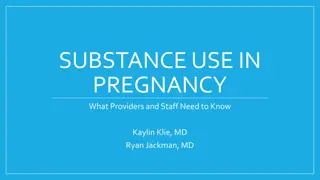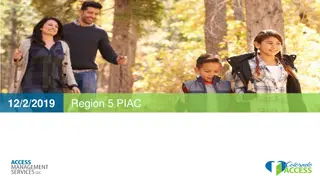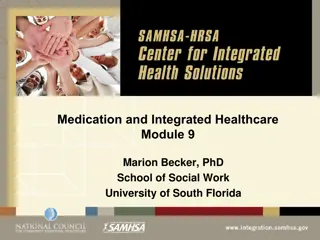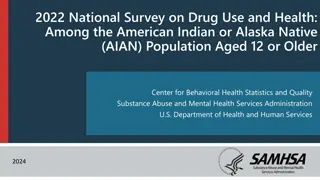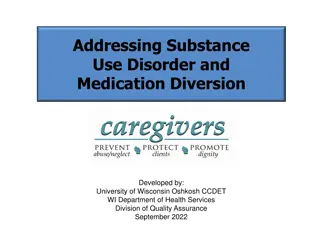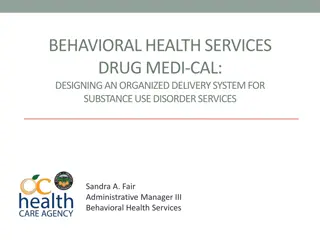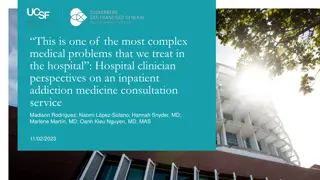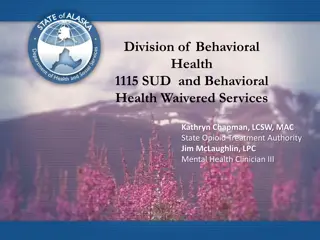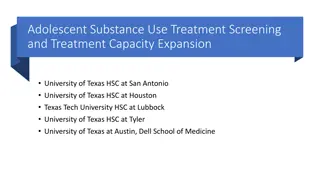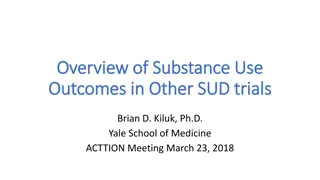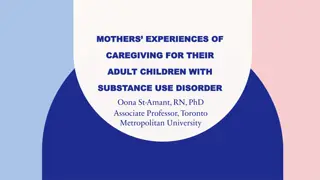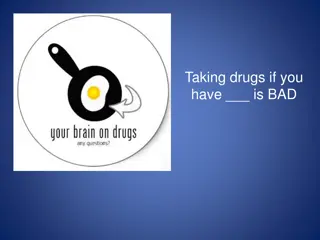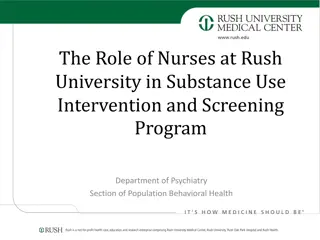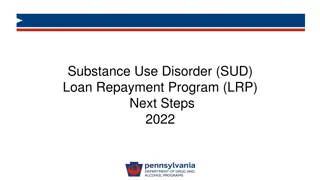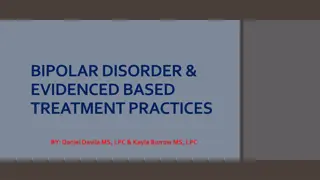Substance Use Disorder (SUD) Care Coordination and Treatment Outcomes Overview
This presentation covers the Substance Use Disorder Care Coordination Performance Improvement Project (PIP) with a focus on Program Improvement Projects (PIPs), SUD treatment outcomes, discharge status by modality, transitions in 30 days, and the impact of care coordination/case management on improving outcomes. It provides insights into the importance of active PIPs, progress measurement in SUD treatment, and the significance of successful transitions in care settings. Additionally, it defines case management according to SAMSHA guidelines.
Download Presentation

Please find below an Image/Link to download the presentation.
The content on the website is provided AS IS for your information and personal use only. It may not be sold, licensed, or shared on other websites without obtaining consent from the author.If you encounter any issues during the download, it is possible that the publisher has removed the file from their server.
You are allowed to download the files provided on this website for personal or commercial use, subject to the condition that they are used lawfully. All files are the property of their respective owners.
The content on the website is provided AS IS for your information and personal use only. It may not be sold, licensed, or shared on other websites without obtaining consent from the author.
E N D
Presentation Transcript
Substance Use Disorder (SUD) Care Coordination Performance Improvement Project (PIP) QI & UM November 2022 Rashad Eady Quality Improvement, Program Specialist Lori Shallcross LCSW Utilization Management, Clinical Review Specialist
WHAT ARE PIPs? Program Improvement Projects (PIP): As a Medi-Cal funded Mental Health Plan (MHP) and Drug Medi- Cal Organized Delivery System (DMC-ODS), we are required by Federal regulation and State contract to have various active PIPs at any given time. A PIP is a project designed to address an identified problem and achieve significant improvement, sustained over time, in health outcomes and client satisfaction. A PIP may be designed to change behavior at a client, provider, and/or system level. 2
SUD Treatment Outcomes Definition of Progress Made Progress o Comp Tx/Rcvr Plan Goals/No Ref Comp Tx/Rcvr Plan Goals/Ref o Left w/Satis Prog/No Ref Left w/Satis Prog/Ref No Progress o Left w/Unsatis Prog/No Ref o Left w/Unsatis Prog/Ref Excludes Death & Incarceration 3
SUD Treatment Outcomes Discharge Status by Modality Almost 50% of the clients receiving services in Residential settings are discharged without making any progress. 4
SUD Treatment Outcomes Discharge Status by Modality Transitions in 30 Days No Modality Perinatal Residential Percent 74% Clients discharging from Residential services only successfully transition to the next level of care 27% of the time. Yes 26% Residential No Yes No Yes No Yes 74% 26% 71% 29% 89% 11% Residential Withdrawal Management Sobering 5
Care Coordination/ Case Management Improves Outcomes NOTE: Care coordination and case management will be used synonymously throughout this presentation. 6
Substance Abuse & Mental Health Services Administration (SAMSHA) Definition of Case Management SAMSHA General Definition: Coordinated, individualized approach that links clients with appropriate services to address their specific needs and help them achieve their stated goals. 7
SUD Care Coordination PIP Overview GOAL: Improve SUD outcomes in Alameda County residential treatment programs by increasing care coordination services for beneficiaries. SAMHSA/Multi-County Best Practices and Areas of Focus for Improving Care Coordination: Family and support Social connection/concerns Frequency of Care Coordination contacts Transitions in level of care Physical health concerns 8
The Nuts and Bolts Billing for Case Management Services 9
ACBH BILLING CODES FOR CASE MANAGEMENT SERVICES Level of Care 3.1 Billing Code 112 113 Service Provided CM Care Coordination Service Coordination 3.3 142 143 CM Care Coordination Service Coordination 3.5 172 173 CM Care Coordination Service Coordination CM Service Description of Service Coordination of care for clients in DMC-ODS without disruptions to services; this would include any care coordination to transition to a lower level of SUD care. CM-Care Coordination Services provided to assist clients to access needed medical, educational, social, prevocational, vocational, rehabilitative, or other community services Service Coordination NOTE: Residential Providers cannot bill the daily rate on the client's date of discharge. However, services provided in transitioning the client to a lower level of SUD care or other service coordination activities can be billed on the discharge date. 10
Case Management Activities The following reference table may be used as a tool to ensure that core functions of case management and their respective activities are being performed. This table offers some examples of activities that could be covered in sessions, when applicable and are billable. The examples should not be considered an exhaustive list of case management activities. NOTE: Case management services must be provided by either registered/certified Counselors or LPHAs in order to be billable. 11
Connection Coordination Communication 12
CASE MANAGEMENT ACTIVITY SCENARIOS The following reference table may be used as a tool to ensure that core functions of case management and their respective activities are being performed. This table offers some examples of activities that could be covered in sessions, when applicable and are billable. The examples should not be considered an exhaustive list of case management activities. NOTE: Case management services must be provided by either registered/certified Counselors or LPHAs in order to be billable. BILLABLE NOT BILLABLE Providing transportation for clients to scheduled appointments (not considered medically necessary treatment) such as driving client to and from DMV to obtain ID card. Helping a client move residences. Driving around looking for a client who went AWOL from the program. Driving to visit a client in the community and waiting for the client, but the client is a no-show for the appointment. Waiting for a client in the lobby during a client s doctor appointment. Linking Clients to housing resources. Assisting clients with applying for Medi-Cal. Transferring Medi-Cal benefits for clients Linking clients to community resources such as food and clothing assistance Providing warm hand-offs to new LOC. Identifying a referral agency and scheduling an appointment for a level of care transition (e.g. from IOP or ASAM 2.1.) Coordinating care to physical and mental health providers to ensure clients are provided appropriate services. Documenting case mgt activities outside of a progress note for services, including information regarding recent primary care and specialist visits, ED visits, auxiliary treatment services (e.g. dialysis) and any community resources received. Although providers are expected to conduct these activities, time spent documenting these activities are not billable if not a part of a direct documented service. Time spent communicating with service providers, county workers, judges, etc. either face-to-face or by phone (e.g. meeting with patient and doctor during a primary care visit) or discussing treatment progress with county partners (e.g. Child, Youth and Family Services, Probation Department. Following up with other agencies regarding scheduled services and/or services received by clients. Entering data into InSyst/Clinician s Gateway; submitting authorizations, progress notes, etc. Attempting but not successfully contacting service providers either by phone or face-to-face (e.g., leaving a voice mail message). Providers should only bill for CM if they are successful in communicating with other services providers on the client s behalf. Providing written reports or communicating via email to health and mental health providers, and county partners (e.g. Child, Youth and Family services, Probation).
Care Coordination Best Practices & Tips Substance abuse clients often arrive in treatment programs with numerous social problems and addressing them in a respectful and timely way makes a difference. Supporting clients in reconnecting with family & friends Assisting in goal planning and following up with the client s progress and future plans Finding and making referrals to other needed services and monitoring the subsequent engagement of the referrals Physical health concerns are one of the number one needed referral. Engaging in advocacy on behalf of individuals to secure additional resources including: Income - GA, CalWorks, employment services Food including CalFresh benefits Phone Always come first with a strength based perspective. 15
SUD PIP Next Steps Set up on-going meetings with care coordination staff to: Track success Identify areas that need improvement Remove any barriers encountered Provide on-going support for: Case notes Data input Care coordination strategies Resources COMPREHENSIVE CASE MANAGEMENT FOR SUBSTANCE USE DISORDEER TREATMENT (samhsa.gov) TIP 27: Comprehensive Case Management for Substance Abuse Treatment (samhsa.gov) 16
Questions and or Feedback? Rashad.Eady@acgov.org Lori.Shallcross@acgov.org 17




